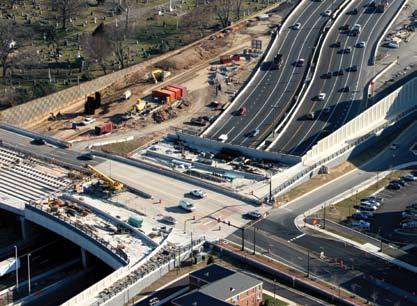
2 minute read
By Stephanie Grimes
from Spring 2006
views of the Potomac. But today’s traffic triples the original designers’ expectations, which causes massive delays and has forced the new 12-lane project. Nicholson’s task probably won’t be remembered as fondly by historians and architecture buffs, but he will find his busts pipes. You keep things going, you go on to the next issue,” he says. “The game is VDOT’s on time and on budget, no matter how big the project is.” Organizers of the 20th Annual Black Engineer of the Year Awards Conference appreciate Nicholson’s coolness under fire, and named him a Modern Day Technology Leader during its February meeting in Baltimore. “I look at it as the nominee for engineer of the year award,” says Nicholson. “It’s an organization that hosts a get-together for African-American professionals to give them recognition across all areas of engineering.” After being project manager for the Fairfax County Highway and playing a large role in the recent Springfield Interchange Project— better known as improvements to Northern but at the University of Kansas his interest shifted to transportation, and he’s had a love affair with bridges ever since. A position with the Federal Highway Administration brought him to Washington DC. When the government wanted him to move to another location, Nicholson quit, took a job with Fairfax County, and ultimately began working for VDOT. Nicholson clearly loves his job. When asked for his favorite bridges, he quickly ticks them off: San Francisco’s Golden Gate and the 1874 Eads Bridge, which crosses the Mississippi near his hometown. He also once marveled at some spans on the Pacific Coast Highway while driving the famed road on vacation. Nicholson also thinks the Wilson Bridge qualifies as a classic; it enables travelers to see beautiful place working a high-profile position in a region known for its traffic, news and cost overruns. So far things are running well. He boasts of meeting schedules and running things on budget, a key accomplishment in the traditionally cost-conscious Old Dominion. He looks at similar projects, such as the Boston Central Artery Project, known as The Big Dig, which went $12 billion over its original $2.6 billion cost. The Wilson Bridge Project, in Nicholson’s words, is setting a precedent for any project over $1 billion. “We’re the only one in recent history that meets the schedules that we propose,” he says. And that schedule includes the completion of the first replacement bridge this summer. Great work, Nick! Virginia’s notorious Mixing Bowl—Nicholson became the first VDOT employee recognized by the conference.
Advertisement
The organization honors many engineers—last year it honored 95 professionals— but Nicholson’s position is unique.
“The project is definitely a once in a career project,” he says of the endeavor that includes the bridge and a g E PR o JEC t series of interchanges. “It R i D b gives me the opportunity to practice engineering. You wilso N find problems everyday, and ow you don’t have time to think and dwell.” he says. woo DR
Not bad from a guy who th E caught the construction bug Y o F as he watched his grandfather t E s R building houses in East Saint Louis. While attending high school, he dreamt of P hoto C ou following his grandfather’s building the much-wider washington street deck replacement over the Capital beltway work on a grander scale, requires careful traffic coordination, both on top and below the structure.



